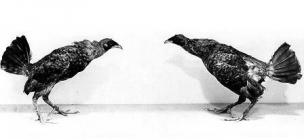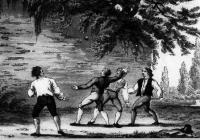The forgotten festivals of Wales
Items in this story:
Gŵyl mabsant
The gŵyl mabsant was one of the most popular rural festivals in Wales. Commemorating the local parish saint, this annual celebration developed from a dedication through prayer to a programme of recreational activities, enjoyed by all.
Gŵylmabsantau was mentioned in writing as early as 1470, and the festival was common throughout Wales up until the end of the 19th century.
From cockfighting to grinning matches
Competitions at the festivals ranged from running races to old women's grinning matches and blindfolded wheelbarrow-driving. At the three day sports event held in Llangyfelach near Swansea in 1780, competitions and prizes included a women's race for a smock and petticoat and eating a hot pudding for a silver table spoon. Animal sports were a familiar scene, particularly cockfights, on which large amounts of money were wagered. Birds were specially trained for the contest, and the owner of a victorious cockerel was held in high esteem.
Early versions of Association Football were often played over Christmas, New Year and at Shrovetide. Large crowds of spectators gathered to witness the matches, which, owing to a lack of pre-determined rules, tended to degenerate into chaos, with injuries being common.
Bando
Bando was another favoured team sport and continued in some areas until the late 19th century. Particularly popular in Glamorgan, bando was similar to the modern game of hockey and teams used clubs to strike the ball towards a goal.
A rowdy reputation
Owing to the combination of betting, feasting and alcohol consumption, it was not surprising that parish festivals built-up a reputation for their rowdiness. Publicans often played a significant role in organising and promoting sports events, many being arranged over the bar. The games contested were high-spirited and unwritten rules were often decided informally before the start of a match. As many sports were localised activities, rules usually differed from place to place, leading to disagreements between parishes.
Concern regarding the unlicensed revelry and alcoholic over-indulgence commonly occurring at the festivals, as well as the doubtful benefits of the games themselves, was increasingly voiced from the 18th century onwards, most noticeably by religious leaders.
Worthless and sinful
The Methodist and other religious revivals which swept across Wales from the mid 18th century until the turn of the 20th century, attacked sporting activities indiscriminately as worthless and sinful. Physical recreation was viewed by some as a great threat to the morals of the population. Eminent religious figures, such as Thomas Charles, tried to suppress impious fairs and festivals, in 1799 he described Wales as "sunk in superstition and vice". Consequently, parishioners turned increasingly to churches and chapels for release and salvation, and as prayer meetings were sometimes purposely arranged to clash with sports days, religion became a potent force in the eventual decline of the Gŵyl Mabsant.
Background Reading
"Gŵyl Mabsant" by T.Llew Jones. In Llafar Gwlad p10-11 (Winter, 1997), p8-9 (Spring, 1998).
"Festivals and social structure in early modern Wales" by Richard Suggett. In Past and Present, vol. 152, p79-112 (August, 1996).

